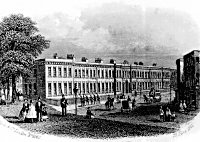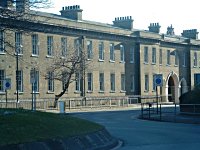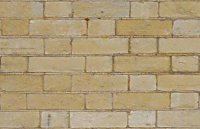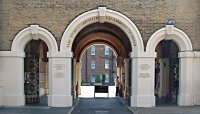
Cambridge Barracks
Up until the Napoleonic wars it was commonplace to billet soldiers in hotels, inns and private houses which in a garrison town such as Portsmouth meant the populace were constantly being asked to support the army. This was not only onerous for the local people but led to indiscipline amongst the troops. In 1792 the army started to think about building barracks but initially did little more than convert existing buildings which is what happened in Portsmouth from 1825 in an area formerly occupied by a Royal Marine Cooperage and Brewery with a main entrance on Penny Street. The original complex was known as Clarence Barracks, after the Duke of Clarence.

With no wars to fight after the defeat of Napolean, the government were reluctant to extend the barracks for the next 30 years, but with the onset of the Crimean War attitudes began to change. The soldiers barracks were upgraded to include amongst other innovations, married quarters. At the same time thought was given to the provision of accommodation for officers for which the government bought land on High Street which included the Portsmouth Theatre, owned by Thomas Ellis Owen. The Officers Quarters was named Cambridge Barracks after Adolphus Frederick, 1st Duke of Cambridge and was built in 1856-57. It remained in use until well after the First World War when the whole complex was purchased for the use of Portsmouth Grammar School who occupied their new buildings in 1927.
Project Considerations

Although by far the largest complex of buildings in the whole project it was assumed that the regimented symmetry of the building would allow mass repetition and so make it relatively easy to reproduce. The first step in the research was to visit Catherine Smith, Archivist at Portsmouth Grammar School who was exceedingly helpful, opening the archives at the school which contain many documents relating to the purchase of the land and several detailed drawings of buildings on the site. Unfortunately this did not include the officers quarters, which was the one part of the barracks area that had to be included in the first phase of the model as it fronted onto High Street. The rest of the barracks would follow in a later phase.

The overall dimensions of the building could be determined by close examination of various OS maps, but this still left a need for many measurements on site. Initially it seemed that the builders had been very consistent in their work with all window openings registering 44 inches in width. Further, the side of the building facing the High Street consisted of a symmetrical layout about the central gateway of seven bays with 5, 11, 2, 4, 2, 11 and 5 windows. However, when it came to examining the side facing the parade ground it was apparent that different forces were at play. There were still 7 bays but this time with 8, 8, 2, 4, 2, 8 and 5 windows, the last group being the officers mess which extends 18 feet into the parade ground. Inconsistencies were noted in the spacing between the windows and with the north wall which is laid out at 83 degrees to the High Street, in order to accommodate the angle between High Street and Keppel's Row.
A major new consideration also presented itself in that the barracks have a basement level of which about half the height is below ground level. There was also an external corridor, accessible by stairs from ground level, running around most of the building apart from the main entrance. This basement level therefore required that the model be extended some 6 feet below the projected datum level.

Another issue that had to be resolved was the difficulty of obtaining an accurate height for the building with no extant plans or elevations available. An initial figure was derived using a combination of counting the brick courses and multiplying by the mean distance between them and digital manipulation of photographs to remove the effects of foreshortening. There was, however, no realistic means of obtaining an accurate height of the roof. Indeed the roof presented further problems in that the pitch was quite low, a parapet wall surrounded it, and there are few suitable observation points. Eventually this was resolved by resorting to Google Earth which delivered a satellite photograph of sufficient resolution to enable a reasonably accurate plan of the roof to be drawn.

Once the geometry of the model had been constructed a decision concerning the final appearance of the block was needed. In the 21st century the brickwork on the officers quarters is a decidedly murky yellow. This was plainly not how it would have looked in 1860 just a few years after it was built. Clues to the original colour of the brick, which was brought in from Sussex, could be found in the main gateway (see photo) which by and large had not suffered from the effects of pollution and erosion. The gateway though presented a problem of its own in that the ceiling was vaulted using a reddish brick and this was not easy to model. Interestingly the bricks appeared to have been carved into the vault shapes after laying, leaving some bricks with quite extraordinary dimensions.

The Officers Quarters exhibit little decoration, though rather more so than the soldiers barracks elsewhere on the site, the main entrance being about as ornate as it gets. Elsewhere there were small decorative flourishes, such as the arch over the door to the mess, the corbels supporting the cornice around the whole building and not forgetting the magnificent carved Coat of Arms above the main entrance (which at the time of writing has not been included in the model).
Modelling the geometry for Cambridge Barracks took about four months, being in part an exercise in determining how the rest of the model would be generated, given that we were probably looking at a million objects in total. Applying the materials was generally done on the fly but this proved unsatisfactory and will be avoided in future. The materials themselves were generated wherever possible from photographs of the Barracks themselves.
REFERENCES
"A History of Cambridge Barracks" by Catherine Smith